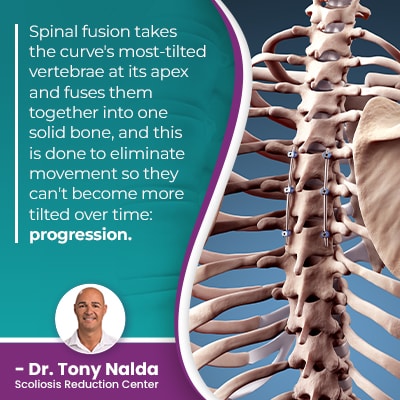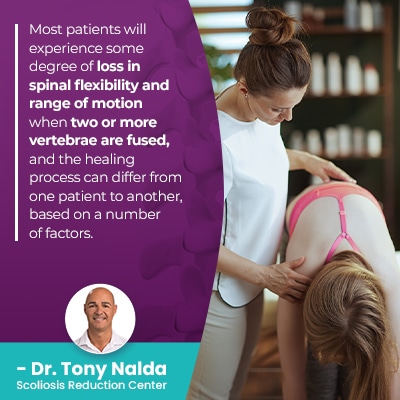Spinal Fusion Recovery: What Can You Expect While Healing?

Spinal fusion surgery offers a traditional scoliosis treatment response, while conservative treatment offers a non-surgical treatment alternative. When it comes to deciding on which treatment approach to commit to, knowing the risks of spinal fusion, and understanding the recovery process, is important.
Spinal fusion can help straighten a bent scoliotic spine, but it's a lengthy, invasive, and costly procedure involving a recovery period. Each patient responds to spinal surgery in their own way, but in general, barring any complications, full spinal fusion recovery can last anywhere from two to six weeks.
Spinal fusion surgery is commonly recommended with traditional scoliosis treatment; let's start with why.
Table of Contents
Scoliosis Treatment Approach
There are two main scoliosis treatment approaches for patients to choose between: traditional and conservative.
The choice of how to respond to a diagnosis with treatment is key because how scoliosis is treated will shape the spine's long-term health and function.
As a progressive condition, scoliosis has it in its nature to get worse over time so where a patient's scoliosis is at the time of diagnosis doesn't mean that's where it will stay.
Conservative treatment starts as close to the time of diagnosis as possible because it's a proactive approach that works towards preventing scoliosis progression, where traditional treatment is more reactive because instead of preventing progression, it responds once a certain severity level has been reached.
In most cases, once a patient has progressed into the severe classification with a Cobb angle measurement of 40+ degrees, spinal fusion surgery is recommended.
What is Spinal Fusion Surgery?
 Spinal fusion surgery is how traditional treatment responds to severe scoliosis, and the goal of spinal fusion is to stop the condition from progressing further, but this isn't the same as impacting the condition on a structural level for true corrective results.
Spinal fusion surgery is how traditional treatment responds to severe scoliosis, and the goal of spinal fusion is to stop the condition from progressing further, but this isn't the same as impacting the condition on a structural level for true corrective results.
Spinal fusion takes the curve's most-tilted vertebrae at its apex and fuses them together into one solid bone, and this is done to eliminate movement so they can't become more tilted over time: progression.
With young patients, counteracting progression is a focus of treatment because growth is what triggers scoliosis to progress.
Fusing multiple vertebral bodies also involves the removal of intervertebral discs that sit between adjacent vertebrae to be fused, and the discs perform many functions that are key to maintaining optimal spinal health and function.
The discs act as the spine's shock absorbers, give the spine structure (adjacent vertebrae attach to the disc in between), combine forces to enable spinal flexibility, and provide cushioning between vertebrae to prevent friction during movement, so their removal is significant.
In addition, once the vertebrae are fused, oftentimes rods are attached on either side of the spine with pedicle screws to hold it in place, and this is contrary to the spine's movement-based design.
Most patients will experience some degree of loss in spinal flexibility and range of motion when two or more vertebrae are fused, and the healing process can differ from one patient to another, based on a number of factors.
Healing From Spinal Fusion Surgery
The process of healing from spinal fusion surgery will be as unique as each condition, and factors that affect the healing process include whether or not there were any complications during the procedure (excessive blood loss, blood clots, adverse reaction to hardware used, spinal nerves damaged, blood vessels damaged, disruptions to blood flow), the number of vertebrae fused, the location of the fusion along the spine, patient age and overall health, condition type, and severity.
The more vertebrae fused, the more likely it is that complications and or side effects will be overt.
In general, most patients spend the immediate days following the procedure in hospital being watched for signs of infection and pain management, and average hospital stays range from 4 to 7 days, barring any complications.
After the initial follow up from the surgeon, patients can continue the recovery process from home, and this will involve continued pain management through pain medication, activity restrictions such as no driving, riding in cars, lifting heavy objects, avoid bending and twisting, and the use of nicotine products; this stage of recovery can last up to 5 weeks, and a raised toilet seat can help with bending restrictions.
In typical recoveries, pain medication will be gradually reduced to ease pain with the goal of patients being medication-free within 6 weeks after surgery, at which time ice packs and gentle stretching can be helpful with further pain management.
After a two-week check up, physical labor restrictions and pain medications to relieve pain are reviewed and adjusted as necessary, and in most cases, patients are cleared for usual activities within 4 to 6 weeks after surgery.
The body's natural healing process will be patient-specific, so it's difficult to give a general estimate of the recovery process, but in most typical cases of spinal fusion surgery without complications, the recovery process will fall within a range of 2 to 6 weeks for adolescents, and adults will fall within an estimate of between 4 and 6 weeks.
The first few weeks after surgery can be difficult, and it's common to feel tired, emotional, and experience moderate to severe pain.
Muscle strength can also be lost during the recovery process, so once activity restrictions are lifted, it can be helpful for patients to undergo physical therapy from a scoliosis-specific occupational therapist; an exercise program designed by physical and occupational therapists can help restore core strength and spinal flexibility.
Once back muscles are strengthened, they can optimally support and stabilize the spine, and this can be an important part of the rehabilitation process that occupational therapists can help with.
Many patients, however, are disappointed with some of the long-term effects of spinal fusion surgery.
Long-Term Effects of Spinal Fusion Surgery
 Remember, fusing vertebral bodies, removing the discs that sit in between, and attaching rods to the spine is a costly, invasive, and risky procedure that can affect long-term spinal health and function.
Remember, fusing vertebral bodies, removing the discs that sit in between, and attaching rods to the spine is a costly, invasive, and risky procedure that can affect long-term spinal health and function.
Regardless of a patient's recovery time, a fused spine is fused for life, and this makes many extreme sports and contact sports too dangerous as a fused spine is weaker and more vulnerable to injury; this can disappoint many patients.
In addition, the rigidity in the fused portion of the spine can cause a noticeable loss in spinal flexibility and range of motion that some patients find disruptive to normal life.
Some patients who have undergone spinal fusion surgery are disappointed that their back pain has actually increased, and this can be due to spinal rigidity and strained muscles surrounding the fusion site.
Spine issues are common following scoliosis surgery, and if a rod cracks, breaks, or a screw dislodges or breaks, nerve damage and/or infection is a risk, and the only recourse is more surgery and facing the risks all over again; in addition, those risks increase with each subsequent surgical procedure and increasing age.
It's important that patients have realistic expectations of life with a fused spine because there can be a big difference between desired treatment outcome and actual results.
For those choosing to forgo a surgical recommendation, there are other treatments available, including chiropractic care, physical therapy, a corrective back brace, and a scoliosis-specific exercise program designed to further rehabilitate the spine: conservative treatment.
Conclusion
While spinal fusion surgery still has a place in scoliosis treatment, and when successful, it can straighten a scoliotic spine, it does carry some serious potential risks and side effects that should be considered carefully.
A patient's response to spinal fusion surgery will be as unique as the patient; important factors that shape a patient's recovery process include whether or not any complications occurred during the procedure itself, patient age and overall health, the number of vertebrae fused, type of bone graft performed, location of the fused vertebrae (cervical, thoracic, or lumbar spinal fusion), condition type, and severity.
When two vertebrae or more are fused together into one solid new bone, several weeks of recovery should be expected; a typical recovery experience involves up to 6 days in the hospital immediately following the procedure while being observed by healthcare professionals, and typical activities can usually be returned to within 5 weeks after surgery.
A follow up visit with the orthopedic specialist will be needed at regular intervals to ensure the fusion process has been a success and that back pain isn't an ongoing issue, and if it is, strategies to reduce pain can be discussed.
If there were any complications in the operating room or during the recovery process, recovery time estimates increase.
Dr. Tony Nalda
DOCTOR OF CHIROPRACTIC
After receiving an undergraduate degree in psychology and his Doctorate of Chiropractic from Life University, Dr. Nalda settled in Celebration, Florida and proceeded to build one of Central Florida’s most successful chiropractic clinics.
His experience with patients suffering from scoliosis, and the confusion and frustration they faced, led him to seek a specialty in scoliosis care. In 2006 he completed his Intensive Care Certification from CLEAR Institute, a leading scoliosis educational and certification center.
About Dr. Tony Nalda
 Ready to explore scoliosis treatment? Contact Us Now
Ready to explore scoliosis treatment? Contact Us Now





